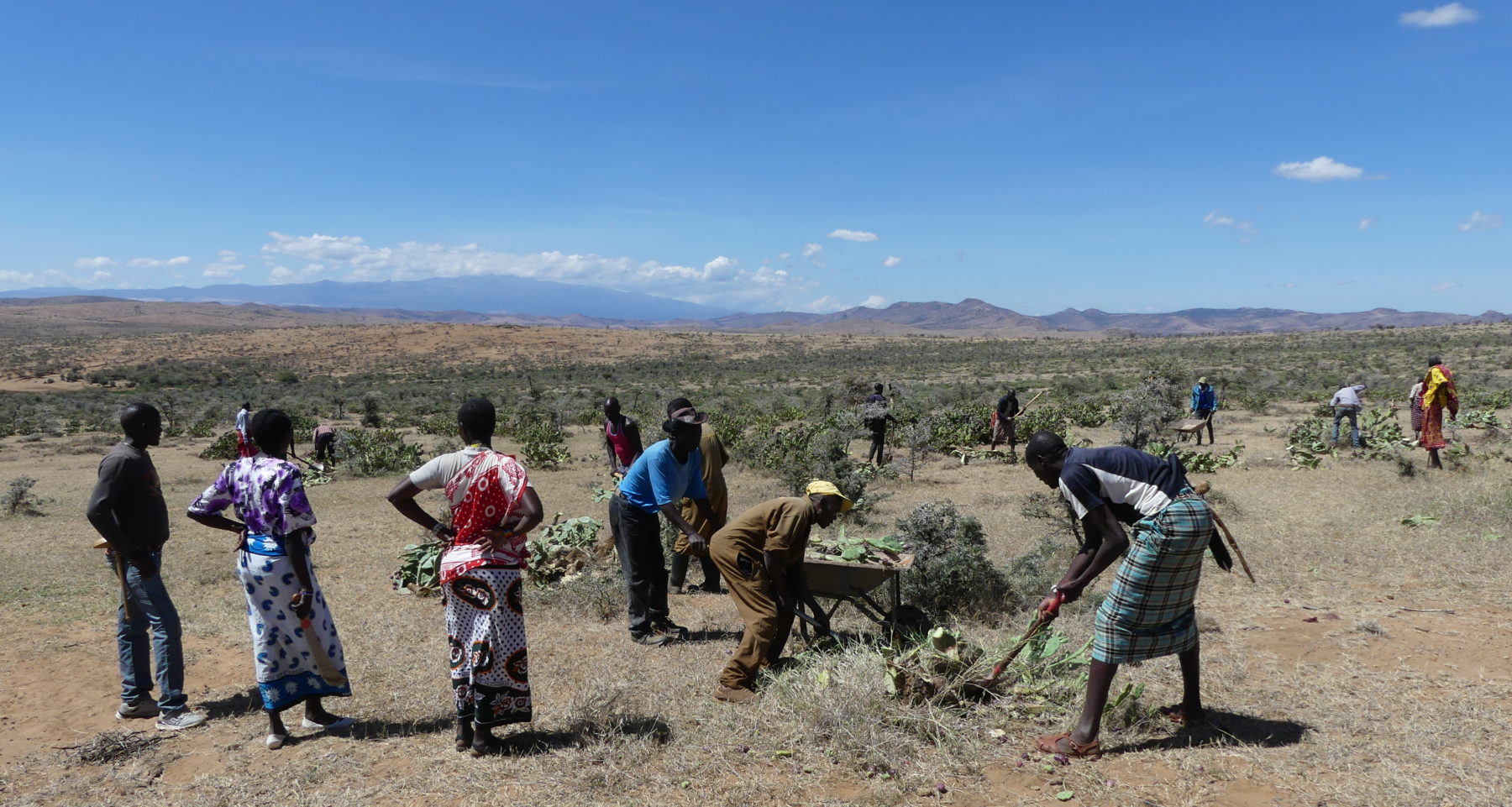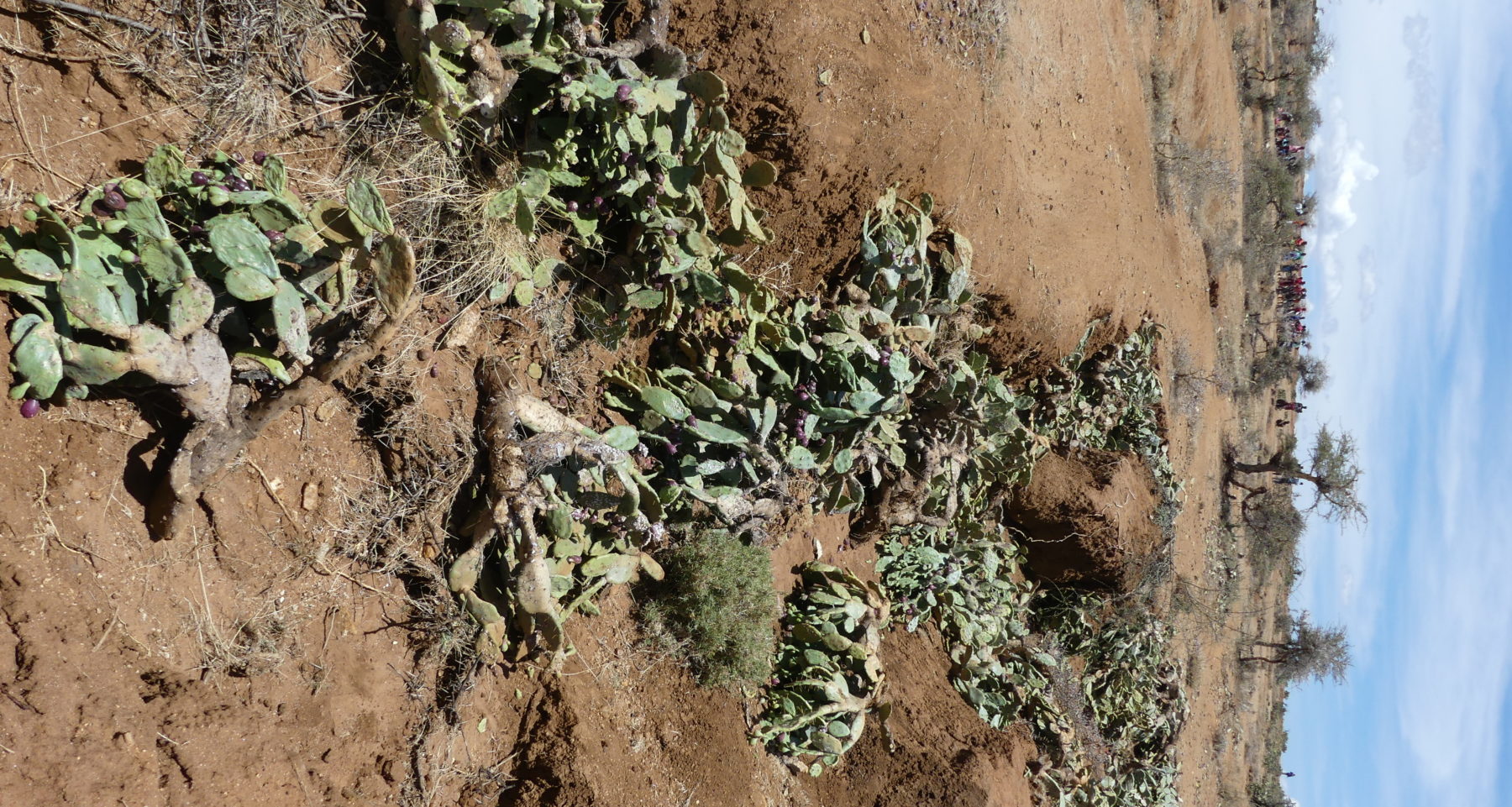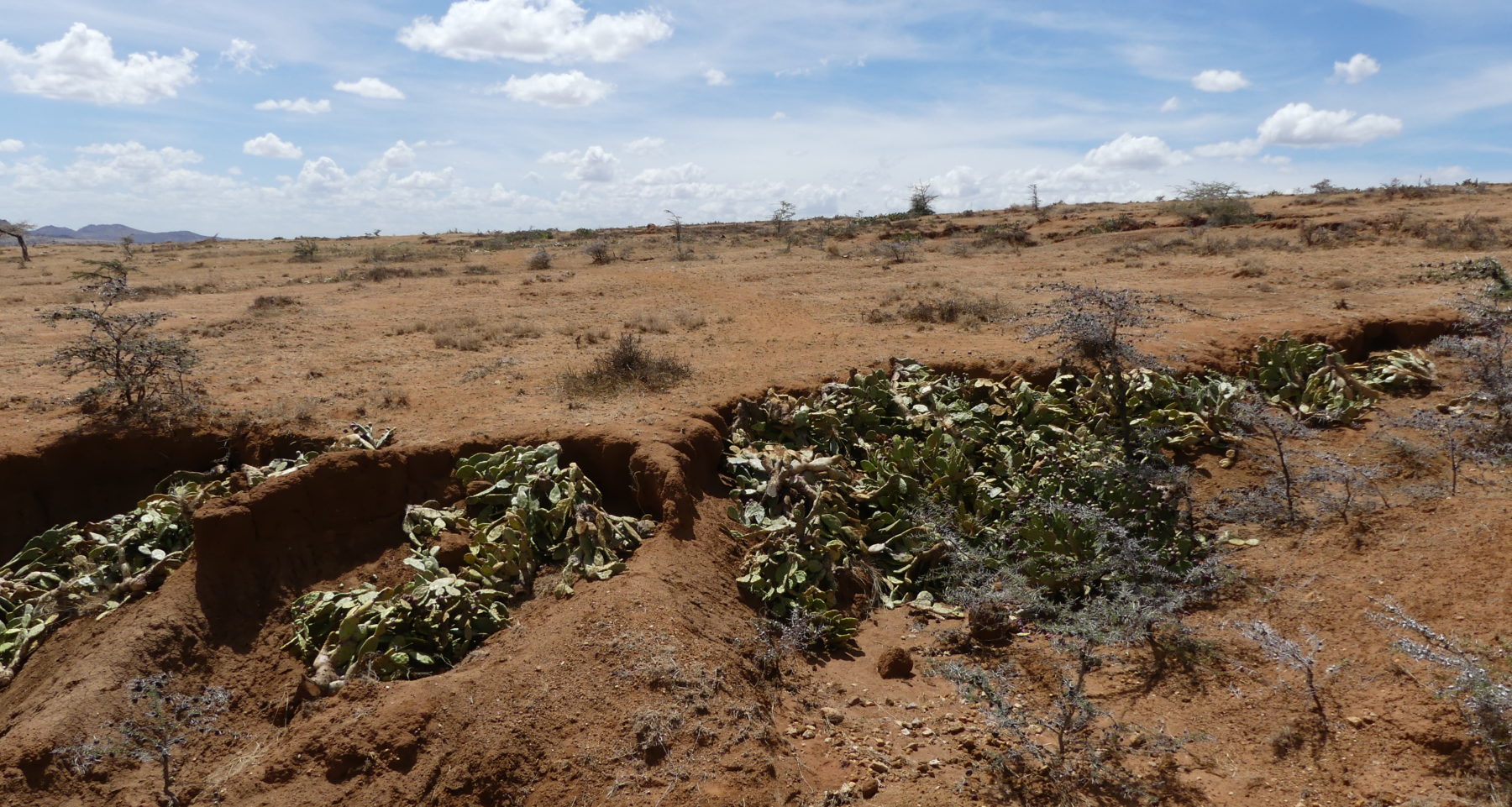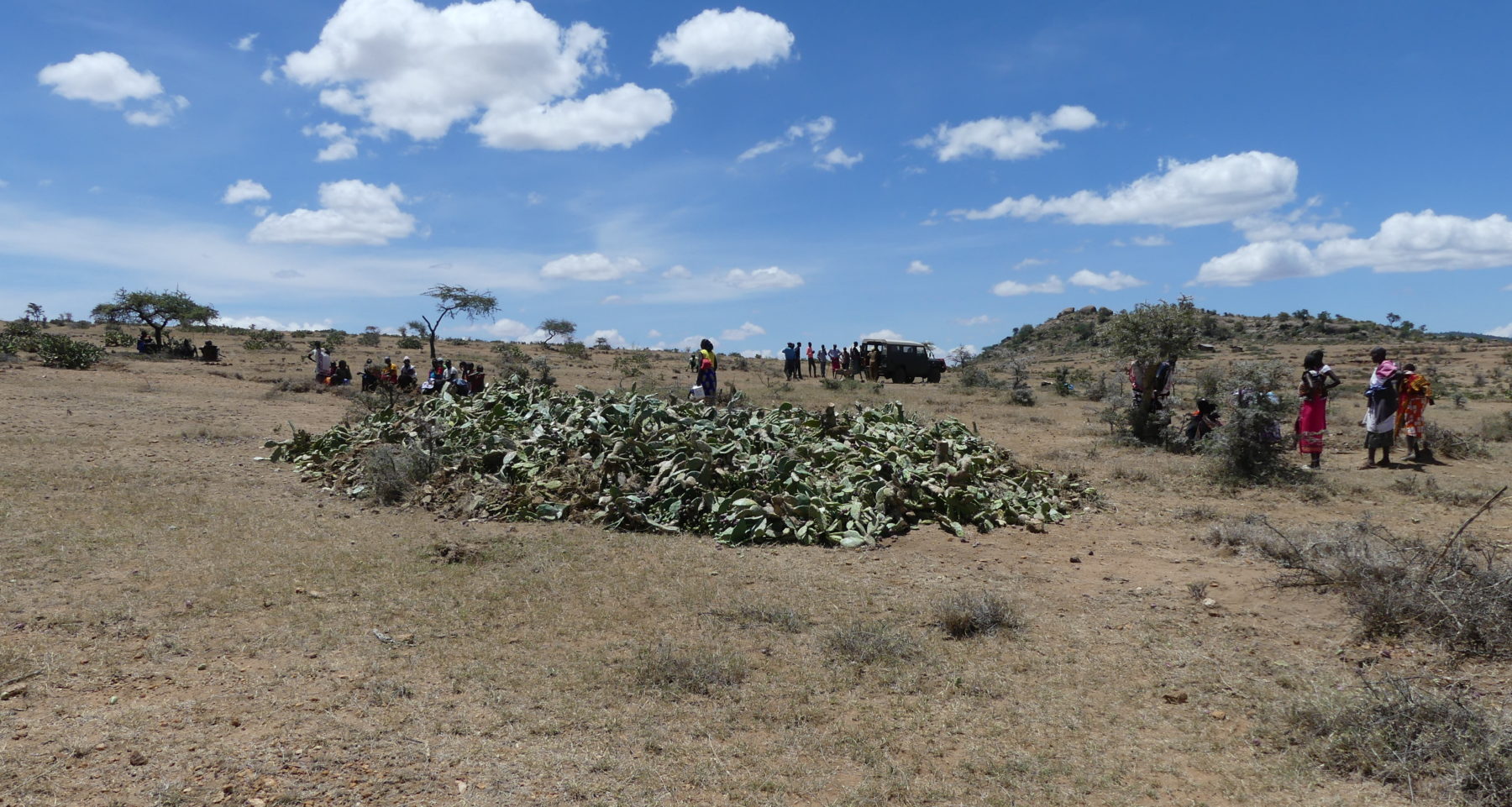Overview
Opuntia stricta is a problematic invasive cactus species in many of the world’s drylands, including Laikipia, Kenya (Shackleton et al., 2017). This project focuses on Makurian Group Ranch, a communally managed rangeland in the Mukogodo area of Laikipia. The members of this Maasai community are pastoralists whose livelihoods depend on livestock husbandry and the O. stricta invasion is perceived as a more serious threat than insufficient grazing (Shackleton et al., 2017). A biological control agent, Dactylopius opuntiae (cochineal), was released several years ago and there was a campaign to grow and cultivate D. opuntiae in a greenhouse so that colonised cladodes could be placed on O. stricta manually to accelerate the spread of the biological control agent. Unfortunately, this project ended when the funding ran out and the spread of D. opuntiae has been very slow. As funding is limited and local communities are strongly motivated to control O. stricta, manual clearing has been proposed by the group ranch members despite its labour intensiveness. The group ranch members compose the vast majority of the stakeholders and have driven this restoration project from conception, through planning and implementation and, in later stages of the project, will lead the monitoring and evaluation.
Quick Facts
Geographic Region:
Africa
Country or Territory:
Kenya
Biome:
Grassland/Savanna
Ecosystem:
Grasslands & Savannas - Tropical
Area being restored:
6,816 hectares
Project Lead:
Makurian Group Ranch
Organization Type:
Community Group
Project Partners:
Makurian Group Ranch
Lolldaiga Hills Research Programme
University of Leeds
World Agroforestry Centre (ICRAF)
Project Stage:
Implementation
Start Date:
2018-09
End Date:
N/A
Primary Causes of Degradation
Agriculture & Livestock, Climate Change, Invasive Species (native or non-native pests, pathogens or plants)Degradation Description
The primary cause of degradation in Makurian Group Ranch and the wider Mukogodo area is the spread of the invasive alien cactus species, O. stricta. Since its introduction to the Mukogodo area in the 1950s, O. stricta spread to an area of 3,200 hectares in 2006, 4,800 hectares in 2008 and 66,200 hectares by 2014 (Strum et al., 2015), now covering 50-75% of the rangelands (Shackleton et al., 2017). O. stricta is dispersed by wildlife (particularly elephant and baboon) and human activity. However, the rapid acceleration of the spread of O. stricta after a lag of over 50 years is more strongly driven by human population growth and the increase in sedentarisation of previously more mobile pastoral communities that reside in the area over recent decades, beginning in the 1997-1998 high rainfall El Niño event. This has led to increased livestock grazing pressure, which, together with increasing frequency and intensity of droughts (Kaye-Zwiebel & King, 2014), has led to a state transition from savanna grassland to degraded rangeland with much bare ground (Strum et al., 2015). The increased prevalence of bare ground is likely to be the proximate cause of the spread of O. stricta, while climatic factors, population growth, sedentarisation, grazing pressure, erosion of customary institutions to manage common property natural resources and the inability to secure land (e.g. against grazing incursions from neighbouring communities) are underlying causal drivers. One of the main impacts of O. stricta is on livestock health (mouth sores, weight loss, general sickness, less milk, death, gastro-intestinal tract issues etc.) and associated negative impacts on livelihoods. In a recent study, almost half of the 200 respondents reported annual losses of USD 500-1,000 (Shackleton et al., 2017). Other impacts include human health (eye and skin irritation from glochids on the fruit), reduced mobility of humans and livestock, restricted access to grass (livestock forage), contraction of grazing area, loss of useful plants (primarily medicinal) and negative impacts on wildlife populations (Shackleton et al., 2017).
Defining the Reference Ecosystem
The reference ecosystem is based on diverse sources of information (e.g. multiple extant reference sites, field indicators, historical records, predictive data).Reference Ecosystem Description
Sites in the landscape that are less severely invaded provide useful extant reference ecosystems, such as those that have lower grazing pressure (e.g. conservation areas, livestock exclosure plots, areas cleared of O. stricta). As the changes in the ecosystem are relatively recent (major alterations occurring within the past 10-20 years), there is also ample local knowledge and social memory of the ecological state prior to the accelerated spread of O. stricta. The main indicator or key attribute that will be monitored is the density of O. stricta and, ideally, the restored system will be free of O. stricta (failing that, minimised as much as possible). We decided on these reference conditions rather than, for example, a system that would be representative of the landscape 50 or more years ago due to irreversible changes (or changes that are impractical to reverse) such as human population growth and increased livestock numbers.
Project Goals
The project’s primary ecological goal is to minimise and, if possible, completely eradicate (locally) O. stricta and the main socio-economic goal is to improve the livelihoods of the resident Maasai pastoral communities. The latter includes human and livestock health, livestock production and household income. Meeting the ecological goal of minimising O. stricta prevalence will enable the socio-economic goals to be achieved and improving livelihoods will facilitate O. stricta management (e.g. by facilitating financial investment in restoration work) so the two goals are closely interrelated. These two goals will improve the state of the rangelands, in turn benefiting wildlife, which is a further intention of the project.
Monitoring
Monitoring Details:
Assessing the prevalence (in this case, area occupied) and density of O. stricta and the socio-economic impacts are the main indices to be monitored. The former will be performed through systematic geo-referenced transects and photographic evidence and the latter will be undertaken via interviews and focus group discussions.
Start date, including baseline data collection:
March 2019
End Date:
ongoing
Stakeholders
The primary stakeholders are the community members of the Makurian Group Ranch within the Mukogodo area. The community is composed of pastoral peoples, the majority of whom are of Maasai ethnicity. The facilitator is a PhD student from a neighbouring property. The Makurian community members conceived the project and defined the project’s focus, goals and methodology. The elders and livestock grazing committee, which is composed representatives from each area of the group ranch, led the mobilisation of their constituency. The members of each constituency collectively decided which areas to focus restoration efforts and what approach to use (e.g. how to manage O. stricta). The facilitator is charged with raising funding (e.g. for equipment) and researching similar restoration efforts both nationally and internationally to enable learning from other projects. A member of the Makurian community acts as both a Maa-English interpreter and a facilitator to ensure constant communication and coordinates among all stakeholders.
How this project eliminated existing threats to the ecosystem:
The threat to the social-ecosystem to be addressed is the control of the invasive cactus, O. stricta. However, it is crucial that controlling O. stricta occurs in conjunction with rangeland management practices that facilitate the establishment of grasses and other herbaceous vegetation to reduce bare ground, thus preventing recolonisation by O. stricta. Areas with good vegetation cover are less impacted by the spread of O. stricta (Strum et al., 2015; personal observation).
How this project reinstated appropriate physical conditions (e.g. hydrology, substrate)",:
Although conducting surveys of substrate and hydrology are not feasible under the current budget, if we are successful in applications to further grant funding, physical conditions of the rangeland in response to restoration work (particularly soil erosion rates) can be assessed. In many areas in Makurian Group Ranch, cut O. stricta are being used to fill erosion gullies, where their growth and establishment are tolerated as they perform soil and water conservation functions and are not competing with grazing land.
How this project achieved a desirable species composition:
The absence of O. stricta, or the minimisation of its prevalence, is the main aim regarding species composition. The grasses and other herbaceous plant species (e.g. for forage or medicine) important for local pastoral livelihoods are still present within the landscape (often growing among O. stricta). Therefore, these species are not at risk and will be able to reestablish in areas cleared of O. stricta under appropriate management.
How this project reinstated structural diversity (e.g. strata, faunal food webs, spatial habitat diversity):
Reinstating structural diversity is not a primary focus of this project as the focus is on removing undesired species rather than introducing lost species. However, as the native flora persist between individual O. stricta we expect that, with appropriate management, native flora will re-establish after clearing the cactus. Therefore, post-restoration, areas that are currently dominated by O. stricta will experience greater evenness rather than species richness.
How this project recovered ecosystem functionality (e.g. nutrient cycling, plant-animal interactions, normal stressors):
Regarding nutrient cycling, as mentioned above, cut O. stricta are being used to fill erosion gullies, where they perform soil and water conservation functions. This means that the nutrients are largely kept within the system. Moreover, the O. stricta growing within the gullies is more productive (and sequesters more carbon) than the alternative bare ground. O. stricta fruit can safely be consumed and the cladodes can be fed to livestock when forage is limited (e.g. during droughts) after the spines are removed (or fed directly to camels without removing the spines). The resulting reduction in soil erosion also prevents nutrients from leaving the system. Rather than re-establishing lost plant-animal interactions, this project focuses more on reducing the relatively recently formed relationships between O. stricta and elephants, baboons and livestock as the cactus' dispersing agents. Finally, increasing access to grazing land by controlling O. stricta will make the local pastoral community more resilient to stressors such as droughts.
How this project reestablished external exchanges with the surrounding landscape (e.g. migration, gene flow, hydrology):
Regarding hydrology, the restoration interventions in this project aim to reduce the loss of water from the system (e.g. via runoff or evaporation). The immediate effect of removing O. stricta will be to expose soil to higher runoff and evaporation rates, but this will be ameliorated under appropriate management after one or two rainy seasons when native vegetation establishes. Herbaceous cover of even 50% reduces the majority of water-induced erosion in these systems.
Activities were undertaken to address any socio-economic aspects of the project:
As mentioned above, O. stricta has several negative socio-economic impacts. These are either direct (e.g. human health) or indirect (e.g. livestock health, livestock products and income). Therefore, removing O. stricta will have positive impacts on the livelihoods of the pastoral communities within Makurian Group Ranch. These communities, like many pastoral communities, socially and politically marginalised so the financial implications of investing in restoration is a major barrier. Consequently, we are applying for grant funding to cover the cost of necessary equipment (e.g. wheelbarrows, hoes, machetes, spades, rakes) and food for individuals volunteering their time to undertake restoration work. Volunteering is a key aspect of this project. One of the lessons from past experience and the experience of other restoration projects in Kenya and in other countries is that paying community members for restoration work can compromise the viability of the restoration work in the long term (Wells, in review). This may be due to the economic phenomenon termed 'crowding out'. When community members are paid to conduct restoration work they may not be motivated to continue when the funding runs out.
Ecological Outcomes Achieved
Eliminate existing threats to the ecosystem:
As the project is in its early stages, thus far, small areas have been cleared of O. stricta as pilot restoration sites in six of the worst affected parts of Makurian Group Ranch. These activities were conducted at the end of the dry season and the re-vegetation of the sites after the next rainy season will be monitored over the coming months.
Reinstate appropriate physical conditions",:
As mentioned above, monitoring this aspect of the project is currently beyond the budget of the project. However, qualitative observations will be made of the effectiveness of O. stricta in controlling soil erosion in gullies.
Achieve a desirable species composition:
In the areas that have been cleared, the species composition is desirable in the sense that O. stricta has been removed and native vegetation remains. However, we await the increase in cover of native vegetation in response to the next rainy season.
Reinstate structural diversity:
The species richness of sites in which O. stricta has been cleared have not been altered as yet, but we hope to see colonisation of native plants after the next rainy season.
Recover ecosystem functionality:
Unfortunately, the effects of clearing O. stricta on ecosystem functionality have not been quantified due to lack of funding and because the project is in its early stages. However, we hope to monitor the impacts of restoration work, particularly on plant-animal interactions.
Reestablish external exchanges with the surrounding landscape:
Again, we have not been able to monitor exchanges with surroundings (e.g. hydrology), but these can be inferred through changes in native vegetation cover. Funding-permitting, we would also like to monitor these effects (particularly on runoff, evaporation and transpiration).
Factors limiting recovery of the ecosystem:
The project is still in its early stages, but a key limitation at present is the lack of funding. We have mentioned monitoring that could be performed with extra funding, but what the stakeholders value more highly are the tools to facilitate the restoration work. Some tools have been purchased, but still far short of the requirements for the larger scale efforts required to manage O. stricta at the scale of the whole group ranch. Communities and women's groups within the group ranch are highly motivated to control O. stricta.
Socio-Economic & Community Outcomes Achieved
Economic vitality and local livelihoods:
As the project is in its early stages, this is yet to be evaluated. However, the project is expected to have positive effects on pastoral livelihoods by improving livestock health and production and thus household income.
Provision of basic necessities such as food, water, timber, fiber, fuel, etc.:
As the project is in its early stages, this is yet to be evaluated. Clearing O. stricta should improve the provision of livestock products such as milk and meat. One innovative household is fermenting the pulp from ground O. stricta cladodes and collecting the methane as a fuel source. If this biogas production is popular and viable among other families, its implementation will improve access to cooking fuel and reduce pressure on woody vegetation and the time and effort required for firewood collection.
Cultural dimensions such as recreational, aesthetic and/or spiritual:
As the project is in its early stages, this is yet to be evaluated. However, a collection of several women's groups keen to preserve Maasai culture has cleared an area of O. stricta. This area is now used for traditional ceremonies and is also used for performing traditional dances for tourists, which not only created cultural value but also created a source of income.
Regulation of climate, floods, disease, erosion, water quality, etc.:
As the project is in its early stages, this is yet to be evaluated. The re-vegetation by native flora after O. stricta is cleared and after one or two rainy seasons will reduce soil erosion after an initial increase (due to exposure of bare ground when O. stricta is cleared). O. stricta in gullies will reduce the force of water runoff, but the extent to which this reduces the impact of flooding is unknown.
Has the project had any negative consequences for surrounding communities or given rise to new socio-economic or political challenges?:
As the project is in its early stages, this is yet to be evaluated. One of the major challenges with restoration work in this area is the inability of group ranches and community conservancies to prevent members of neighbouring communities grazing their livestock. This greatly reduces the incentive to carry out restoration interventions, not only because other members of the community benefit from ones own work, but also members of neighbouring communities may also benefit. One of the advantages of the approach of this project is that a large proportion of the able-bodied individuals participate in the voluntary restoration work, which reduces the risk of feeling that others from the same community are benefiting without contributing. However, grazing incursions from neighbouring communities remains a persistent issue.
Key Lessons Learned
As many others have experienced, widespread voluntary participation has been a great strength. Not only do participants feel ownership over the project (as they are driving each stage from conception to methodology, implementation and monitoring and evaluation), but there is less of a sentiment that others are benefiting without themselves contributing. One area in which restoration actions were not performed was due to divisions in the community (on religious grounds) and lack of communication and coordination, leading to very few people turning up to clear O. stricta. All other areas so far have coordinated well and have worked hard to clear O. stricta, which highlights the importance of good communication and coordination (particularly in communally managed land). Women’s groups were the most effective at coordinating and carrying out restoration work and this was readily admitted by the male members of the group ranch. An important lesson from this project is that as the community identified the issue as key, the motivation to act to address the issue was strong, so even low level of facilitation (organising meetings and providing a few useful tools) led to very active and effective restoration work.
Long-Term Management
Another advantage of the project being community-led and voluntary is that monitoring and long-term maintenance are easier in comparison to donor-funded and externally driven projects. Some communities within Makurian Group Ranch have defined larger areas to clear O. stricta from and are steadily making progress by organising male and female restoration working groups, each of which contributes two days per week. Individuals are generally between 20-45 years-old and are not forced to work, contributing as much or as little work as they like on their allotted working days. The restoration work days tend to be relaxed affairs, the women often accompanied by young children, the older ones often helping where they can. Arrangements of this type are often coordinated by the elders of each area and are the mode in which restoration work is continued over the long term. The main limitation remains the lack of tools and protective equipment such as gloves and overalls to protect against the gochids, which cause skin irritation. But, we hope to raise funding to purchase more equipment to facilitate the restoration efforts and scale-up the O. stricta clearing. As the effectiveness and consequences of the restoration methods used become clear, adaptive management will no doubt be employed to adjust restoration activities. For example, burning and filling gullies are the two main ways in which cut O. stricta cladodes are treated. The consequences of these methods and how they compare to other existing (biogas production, other biological control agents, selling or producing juices/jams/wines from the fruit) or as yet unconceived methods will guide future restoration actions.
Sources and Amounts of Funding
This project is funded as part of a PhD project, which currently has two sources of funding. The University of Leeds Climate Research Bursary Fund and The World Agroforestry Centre (ICRAF). The former has provided GBP 2,000 and the latter GBP 3,500. As this restoration project is one component of the PhD project not all of the grant funding can be allocated to this restoration project. However, other grants are currently in the process of being applied for. The cost per hectare is not yet known but is likely low as voluntary manual clearing is the cheapest (although labour-intensive) method for controlling O. stricta., the main costs being equipment, which can be used for many years and over large areas once purchased (i.e. low recurring costs).
Other Resources
As we are in the early stages of this project, there are as yet no reports/publications and no project website. But, please feel free to contact us for more detailed information on the project.
Related Research
This project is part of a PhD project on sustainable rangeland management in drylands, using Laikipia, Kenya as a case study. The focus is on degradation and restoration processes and their biophysical and socio-economic drivers.Primary Contact
Name:
Harry Wells
Affiliation:
Lolldaiga Hills Research Programme
City:
Nanyuki
State:
Laikipia





